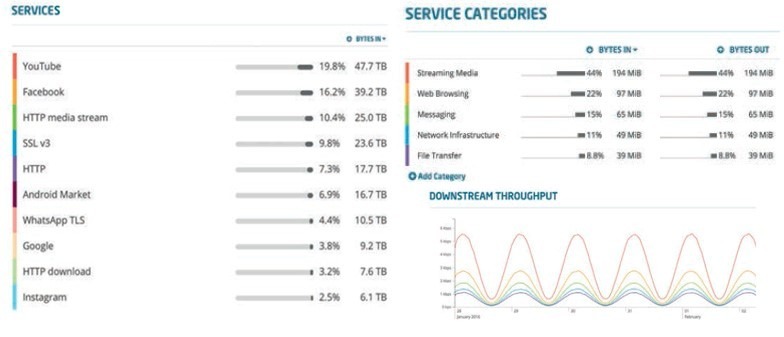
American Internet service providers (ISPs) have started to limit the maximum amount of downloaded data not only in cellular data networks but also in dedicated line connections. Is it relevant in worldwide networks, and how it will affect the quality of service and the operator’s income?
How much Internet do we use and why?
Past few years the speed of Internet access has increased dramatically. ISPs offer their subscribers a speed up to 100 Mbps and higher (of course, this is the peak speed, which is only achievable at certain times using special equipment). At the same time, mobile broadband operators switched to the 5G standard, so it is possible that soon they also could reach these indicators. The offer for the Internet with such a speed is reasonably caused by consumer demand, so the provider simply is trying to satisfy it.
The questions are:
- Why does the user need such speed?
- How to comply with QoS?
- How to make a profit on this demand?
Let’s take a closer look at where the subscriber’s speed goes and the telecom operator’s traffic.

Streaming video
The amount of downloaded data from video streaming platforms is constantly growing. The reason for that is the improvement in video quality and the development of video delivery technologies. Earlier users were limited to HD quality (720 p), nowadays FHD (1080 p) has become the usual standard, and it is being replaced by UHD (2160 p), panoramic video, and augmented reality.
The bandwidth requirements from one of the largest video streaming platforms: 25 Mbps for a video in UHD-quality viewing, which corresponds to 16-20 GB of downloaded data in the time it takes to watch one movie. Procera’s research into traffic consumption when using a virtual reality helmet has shown the minimum speed required is about 10 Mbps, and switching to Full 360 VR UHD quality will raise the bar to 60 Mbps.
Torrents
We put them in second place, although torrent services are direct competitors to online movie theaters (usually, users are divided between those who just want to watch a movie and those who download it first and then watch it). Research showed that about 40% of all Internet users prefer the BitTorrent network, they download more than a million torrent files daily, and the total download speed is more than 20 Gb/s. This is a colossal amount of downloaded data.
Social networks
The social media traffic is astounding not so much in volume as in the number of subscribers and the messages they generate. According to We are Social research, in January 2020 the worldwide number of social network users was 3.8 billion. This is also a large load on the ISP’s Internet channel.
Web surfing and file downloads
Web HTTP browsing and file downloads account for more than 10% of all bandwidth usage, which is not bad considering the total amount of traffic measured in tens of terabytes.
All of these types of content are putting more and more strain on the carriers’ networks and their UPLINKs. The user wants to work at high speed, which the provider must provide under the contract, but should not pump out petabytes of data by using unlimited tariffs. In conditions of big remoteness from traffic exchange points, the connection speed does not exceed 1 Mbit/s on all tariff plans, and the limit is set on the amount of downloaded data: from 200 MB to 16 GB. Is it a good idea to adopt this experience in large cities and introduce restrictions on certain tariff plans?
American “unlimited” tariffs
Over the past few years AT&T, Comcast, and Time Warner have repeatedly experimented with limiting the amount of downloadable data on broadband networks. Time Warner’s first attempt was back in 2009 with a $5-a-month tariff of 5GB of data.
Comcast, too, has long been testing this kind of restriction in some regions by tying the amount of data downloaded to the plans’ speed. Depending on the plan, the limit ranges from 150GB to 300GB. Many home users of AT&T already have a 150GB limit, and subscribers to the U-Verse ISP have a 250GB limit. Comcast now has higher ranges: from 300 to 600 GB depending on the level of service chosen.
Providers explain these measures by users of the network who create a very large amount of traffic to download. So the situation is that they use more traffic unlike most, and all of the subscribers pay the same. For example, one user’s monthly traffic consumption on Verizon’s network is more than 38 terabytes. Although AT&T claims that only 2% of users (based on downloaded data statistics) account for 20% of the total available bandwidth on its network, there is no reason to impose restrictions and displease all other subscribers.

However, the peculiarities of American legislation that requires telecom operators to make large capital expenditures on cable networks, and the desire to earn more on a market economy are the main reasons for tariffs with a limit of downloadable traffic. Ordinary users probably don’t notice the limitation as it’s difficult for them to overcome the limit of 250 GB per month. On the other hand, very active and inattentive users receive large Internet bills because they don’t keep track of their traffic consumption.
All these restrictions primarily apply to large families, where each member creates its own traffic, which in total may not fit within the allowed limit and requires its expansion for an additional fee. But if there are those who want to download terabytes of data at a speed of 300 Mbit/sec, then it makes sense to set special tariffs for them, to raise ARPU and justify the development of the ISP’s network.
How DPI can help
DPI systems work as a kind of network assistant — they help to fit 10,000 subscribers with an average rate of 20 Mbps into a total channel of 20 Gbps.
Deep traffic analysis devices (DPI technology) allow all traffic to be prioritized by giving certain applications and protocols a higher or lower bandwidth, or by placing limits on the amount of downloaded data.
This means that the ISP can set a limit on torrent downloads without affecting all other traffic. If the network is not busy, then an ordinary user can download such files at maximum speed. But if the bandwidth of the common channel becomes insufficient — the speed will drop. You can retract such a restriction with an additional paid option. This functionality allows you to provide an even flow of traffic for all applications, preventing stuttering video and sound, and ensuring fast loading of web pages.
Thereby, ISP gets an additional tool to provide QoS, extra profit, and satisfy subscribers’ demands.
For more information on QoS provisioning in the networks of carriers, as well as other functions of DPI systems and their practical application you can ask VAS Experts specialists.